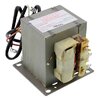JaforSadik
New Member
Hello,
So I want to make a welding machine out of 2 Microwave Transformers. I know nothing about Transformers. I saw a how-to guide and some videos. It's kind of my curiosity and strong will to make this because in my country the welders charge a huge amount for some minimal work, I want to do on my own. so please help me.
How To Make a Welding Machine( From what I learned)
1. take a microwave transformer, cut the secondary winding, and make a new winding with a 4mm insulated copper wire which has 30 turns to ensure insulation and lamination make another one similarly and connect them both, you should get a final output of 50-55 Volts and 150-160 amp.
So I am facing these Problems
1. I cannot Find a used or broken transformer and if I try to buy a new one the amount becomes the same as buying a brand-new welding machine. Still, I found someone who sells empty cores and I have to do the winding myself so my question is how to do the primary coil which will take the input of 220 volts.
secondly, if you guys have any suggestions or tips to make this welding machine more durable and lasting and increase the amp or safety tips please help me by giving your suggestions.
So I want to make a welding machine out of 2 Microwave Transformers. I know nothing about Transformers. I saw a how-to guide and some videos. It's kind of my curiosity and strong will to make this because in my country the welders charge a huge amount for some minimal work, I want to do on my own. so please help me.
How To Make a Welding Machine( From what I learned)
1. take a microwave transformer, cut the secondary winding, and make a new winding with a 4mm insulated copper wire which has 30 turns to ensure insulation and lamination make another one similarly and connect them both, you should get a final output of 50-55 Volts and 150-160 amp.
So I am facing these Problems
1. I cannot Find a used or broken transformer and if I try to buy a new one the amount becomes the same as buying a brand-new welding machine. Still, I found someone who sells empty cores and I have to do the winding myself so my question is how to do the primary coil which will take the input of 220 volts.
secondly, if you guys have any suggestions or tips to make this welding machine more durable and lasting and increase the amp or safety tips please help me by giving your suggestions.

